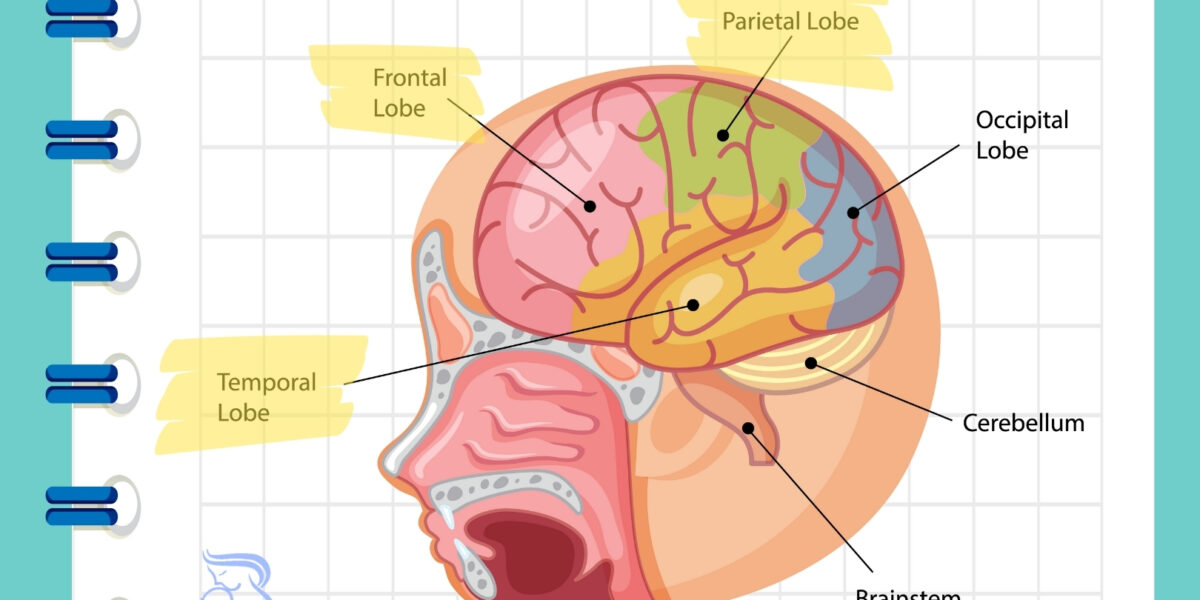Speech and language are clearly highly interrelated, but they are not interchangeable (1). Speech refers to the physical act of expressing words and sounds, and encompasses the act of the muscles in the lips, tongue, vocal tract, and jaw that make recognizable sounds. Language, on the other hand, refers to communicating in a systematic and meaningful way.
What are speech delays & language disorders?
Because language is related to intelligence, disorders in language acquisition and expression are generally considered more serious than speech disorders. There are two broad categories of language disorders (1):
- Expressive language disorder: The ability to communicate meaning to others
- Receptive language disorder: The ability to understand someone else’s message
Language disorders can be expressive, receptive, or mixed receptive-expressive. The signs and symptoms of these disorders can vary depending on the type of disorder a child has.
Signs of expressive language disorders
Some common signs of expressive language disorders include (2):
 Difficulty constructing grammatically correct or complex sentences
Difficulty constructing grammatically correct or complex sentences - Difficulty using standard grammar conventions
- Difficulty finding words
- Overuse of placeholder words like ‘um’ or ‘uh’
- Smaller vocabulary than is age-appropriate
- Repetition of certain phrases
- Echoing of questions in responses
Signs of receptive language disorders
Some common signs of receptive language disorders include (3):
- Difficulty understanding speech
- Lack of interest or minimal interaction when hearing stories
- Interrupting others in conversation
- Difficulty following spoken direction
- Difficulty answering questions, or answers different questions than the ones asked
- Difficulty organizing thoughts
Jump To:
- Speech delays and language disorders associated with HIE
- When should a child get speech-language therapy?
- What causes speech delays and language disorders?
- Therapy for speech delays and language disorders
- What happens during speech language therapy?
- Why is speech-language therapy important?
- Additional benefits of speech-language therapy
- About HIE Help Center
How are speech delays and HIE related?
Brain injury due to hypoxic-ischemic encephalopathy (HIE) is rarely confined to a single area of the brain. Because oxygen deprivation affects the connections in the brain on a global level, it is often possible that children with HIE will have multiple interrelated delays in development.
Children with HIE can sometimes have delays in developing speech and language. Some kids with HIE may remain non-verbal and require the use of alternative or augmentative communication (AAC) technologies to assist them in communicating their thoughts, needs, and desires. Developing a method for communicating helps these children interact with others, develop relationships, learn, work, and socialize.
Speech delays and language disorders associated with HIE
There are several conditions that are common in certain children with HIE. Speech and language conditions can be improved via intensive speech-language pathology treatment, and can include:
- Aphasia: Aphasia is a language disorder that results from brain damage in a specific part or parts of the brain (4). It can manifest in difficulty writing, reading, understanding, or talking.
- Dyspraxia: Dyspraxia is a developmental coordination disorder that affects fine and/or gross motor coordination (5). Some individuals with dyspraxia experience difficulties with coordinating the muscle movements required for spoken language.
- Dysprosody: Dysprosody is a disorder that does not affect the language or the words themselves, but the timing, cadence, rhythm, or intensity of the words (6).
- Dysarthria: Dysarthria is an abnormal facial muscle tone condition that results from brain damage (7). It affects muscles in the mouth, lips, tongue, or throat used for speech.
- Fluency Disorders: A speech disorder that relates to rate, smoothness, continuity, or effort in speech (8). The most common fluency disorder is stuttering.
- Dysphagia: Dysphagia is a condition that involves difficulty swallowing (9). It can manifest in many different ways, but involves general pain and hoarseness when speaking.
- Resonance Disorders: Resonance disorders involve abnormalities in the vocal tract that affect the sound of speech (10).
When should a child get speech-language therapy?
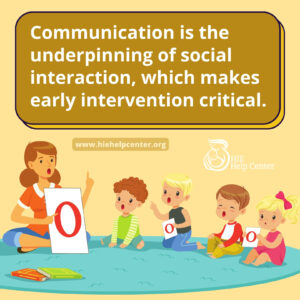 If a child is not acquiring speech or language at the usual rate, it is recommended that parents work with the child’s pediatrician to have the child evaluated as soon as possible (during infancy or very early childhood).
If a child is not acquiring speech or language at the usual rate, it is recommended that parents work with the child’s pediatrician to have the child evaluated as soon as possible (during infancy or very early childhood).
It is critical to make these diagnoses early, so the child may be enrolled in an Early Intervention (Zero to Three, Head Start, Early On) program to mitigate some of the difficulties associated with poor communication. These programs are most effective when a child is very young. Beginning speech therapy programs at an older age means that the child must also take the extra step of unlearning old frameworks and developing new ones.
Could it be a hearing problem?
It is also worth noting that sometimes speech and/or language delays can result from hearing-related deficits. Hearing problems may make it appear that a child has a language or speech issue when they only require a hearing aid or medical intervention to get their speech and/or language development on track.
What causes speech delays and language disorders?
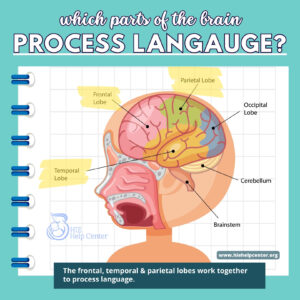 Delays in speech and/or language can be due to several root causes. In some children, HIE-related speech/language disorders are due to damage to the part of the brain responsible for processing language, which can require a different approach from speech/language disorders arising from damage to parts of the brain that control the muscles of the throat, mouth, and jaw (a common feature of cerebral palsy stemming from HIE).
Delays in speech and/or language can be due to several root causes. In some children, HIE-related speech/language disorders are due to damage to the part of the brain responsible for processing language, which can require a different approach from speech/language disorders arising from damage to parts of the brain that control the muscles of the throat, mouth, and jaw (a common feature of cerebral palsy stemming from HIE).
A licensed speech-language therapist will be able to determine the best way to assist a child with a speech/language disorder, working with the child’s caregiver team of physicians, physical therapists, psychologists, and social workers to help the child overcome cognitive or developmental difficulties that can make communication difficult.
Therapy for speech delays and language disorders
Usually, when a child is evaluated and found to have a speech or language disorder, they can be referred to a speech-language pathologist (SLP). An SLP is a certified professional with a minimum of a Master’s degree in speech and language pathology. SLPs have training in:
- Pathology
- Audiology
- Anatomy and physiology
- Linguistics and phonetics
- Human development and
- American Sign Language (ASL)
Parents seeking a speech-language pathologist for their children can request assistance at a variety of locations, as speech-language pathologists are often available at clinics, community health centers, hospitals, rehabilitation centers, public schools, nursing homes and state health departments.
In some circumstances, children receive one-on-one services with additional exercises that they practice at home with parents outside of therapy sessions. In other instances, speech-language pathology services are provided in a small group setting. Sometimes, these services can be provided in a home setting without having to travel.
What happens during speech language therapy?
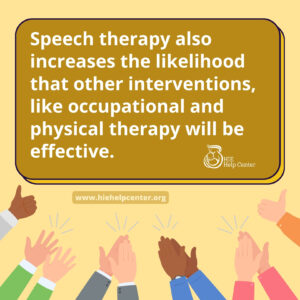 First and foremost, it is important to remember that each child is different, so the exercises that a speech-language pathologist recommends may differ substantially from child to child. For children who are verbal, speech-language therapy can help them (11):
First and foremost, it is important to remember that each child is different, so the exercises that a speech-language pathologist recommends may differ substantially from child to child. For children who are verbal, speech-language therapy can help them (11):
- Pronounce words more clearly
- Listen to and understand conversation
- Use words properly
- Understand grammar
- Have a bigger vocabulary
- Comprehend conversation
- Speak in complex sentences
- Speak conversationally
- Exercise memory and recall
- Understand the differences and similarities between written text and spoken words
A speech-language pathologist will not only help the child physically form words needed for communication but will also develop a training regimen designed to help the child’s brain interpret and understand words, sounds, numbers and gestures.
What if my child is non-verbal?
Some children with HIE may be non-verbal. When working with children who are nonverbal, speech-language pathologists can (12):
- Create and encourage alternative communication strategies, such as gestures, sign language, writing, and others
- Improve social skills through role playing, social stories, and other tools
- Focus teaching on the language, through comprehension, sequencing, and other tools
- Aid in communication through reading
Why is speech-language therapy important?
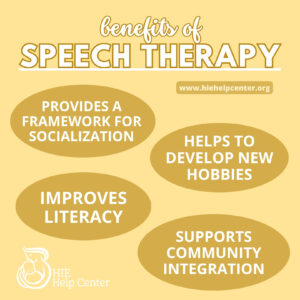 Communication is the underpinning of social interaction, which makes early intervention critical. Developing a communication system helps to ensure that the child will have frameworks in place for inclusion and socialization, allowing them to more fully engage with their surroundings, participate in activities in school or at home, learn new skills, and develop new hobbies or interests.
Communication is the underpinning of social interaction, which makes early intervention critical. Developing a communication system helps to ensure that the child will have frameworks in place for inclusion and socialization, allowing them to more fully engage with their surroundings, participate in activities in school or at home, learn new skills, and develop new hobbies or interests.
This therapy also increases the likelihood that other interventions will be effective. Because other types of therapies are dependent on the child’s ability to comprehend and follow instruction, speech-language therapy is a crucial part of a child’s multidisciplinary therapy regimen. Speech-language therapy supports learning, education, literacy, and community integration.
Are there any risks to speech-language therapy?
There are no risks to speech-language therapy. Delaying speech-language pathology can increase the risk of isolation or depression, and can mean that other areas of development (social, educational, psychological, etc.) may also slow without continued communication-related support.
Additional benefits of speech-language therapy
 Speech-language therapy revolves around the use of the muscles involved in the functioning of the throat, mouth, and jaw. While communication is the primary goal of speech-language therapy, it often has the added benefit of helping children drink, eat, breathe and chew more effectively as well. The therapy can be catered to a child’s specific needs.
Speech-language therapy revolves around the use of the muscles involved in the functioning of the throat, mouth, and jaw. While communication is the primary goal of speech-language therapy, it often has the added benefit of helping children drink, eat, breathe and chew more effectively as well. The therapy can be catered to a child’s specific needs.
Often, children with HIE who have cerebral palsy will have a degree of impairment in eating and drinking (dysphagia); speech-language pathologists can assist these children in improving complex muscle coordination. This decreases the risk that a child will aspirate their food (which can lead to choking and/or pneumonia), have abnormal breathing, increased coughing, dehydration, or malnutrition.
Related speech and language-related resources:
- University of Michigan: Speech and Language Delay and Disorder Quick Reference
- What Does Normal Speech Acquisition Look Like?
- Speech Therapy: How it Works, What to Expect
- How Long Does it Take For Speech Therapy to Work?
- Encyclopedia of Children’s Health: Language Delays
- A Parent’s Guide to Speech and Language Disorders
About HIE Help Center
The HIE Help Center is run by ABC Law Centers, a medical malpractice firm exclusively handling cases involving hypoxic-ischemic encephalopathy and related birth injuries. Our attorneys have been advocating for disabled children since the firm’s inception in 1997.
If you suspect your child’s HIE may have been caused by medical negligence, contact us to learn more about pursuing a case. We provide free legal consultations, during which we will inform you of your legal options and answer any questions you have. You pay nothing throughout the entire legal process unless we obtain a favorable settlement.
Sources:
- Koslo, E. (n.d.). What’s the Difference Between a Speech Impairment and a Language Disorder? Retrieved May 21, 2024, from https://www.understood.org/en/learning-attention-issues/child-learning-disabilities/communication-disorders/difference-between-speech-impairment-and-language-disorder
- Developmental Expressive Language Disorder (DELD). (2018, May 23). Retrieved May 20, 2024, from https://www.healthline.com/health/expressive-language-disorder-developmental#symptoms
- Rosen, P. (n.d.). Receptive Language Issues: What You’re Seeing. Retrieved May 20, 2024, from https://www.understood.org/en/learning-attention-issues/child-learning-disabilities/communication-disorders/receptive-language-issues-what-youre-seeing
- Aphasia. (n.d.). Retrieved May 21, 2024, from https://www.asha.org/public/speech/disorders/Aphasia/
- Dyspraxia. (2022, August 09). Retrieved May 21, 2024, from https://my.clevelandclinic.org/health/diseases/23963-dyspraxia-developmental-coordination-disorder-dcd
- Dysprosdy. (2024, May 05). Retrieved May 20, 2024, from https://www.speechdisorder.co.uk/dysprosody.html
- Dysarthria. (n.d.). Retrieved May 21, 2024, from https://www.asha.org/public/speech/disorders/dysarthria/
- Fluency Disorders. (n.d.). Retrieved May 21, 2024, from https://www.asha.org/practice-portal/clinical-topics/fluency-disorders/
- Dysphagia. (2023, October 26). Retrieved May 21, 2024, from https://www.mayoclinic.org/diseases-conditions/dysphagia/symptoms-causes/syc-20372028
- Resonance Disorders. (n.d.). Retrieved May 21, 2024, from https://www.asha.org/Practice-Portal/Clinical-Topics/Resonance-Disorders/
- Who Are Speech-Language Pathologists, and What Do They Do? (n.d.). Retrieved May 21, 2024, from https://www.asha.org/public/Who-Are-Speech-Language-Pathologists/
- 5 Reasons Why Speech & Language Therapy is Crucial for a Non-Verbal Child. (2015, May 14). Retrieved June 28, 2019, from https://www.friendshipcircle.org/blog/2015/05/14/5-reasons-why-speech-language-therapy-is-crucial-for-a-non-verbal-child/

